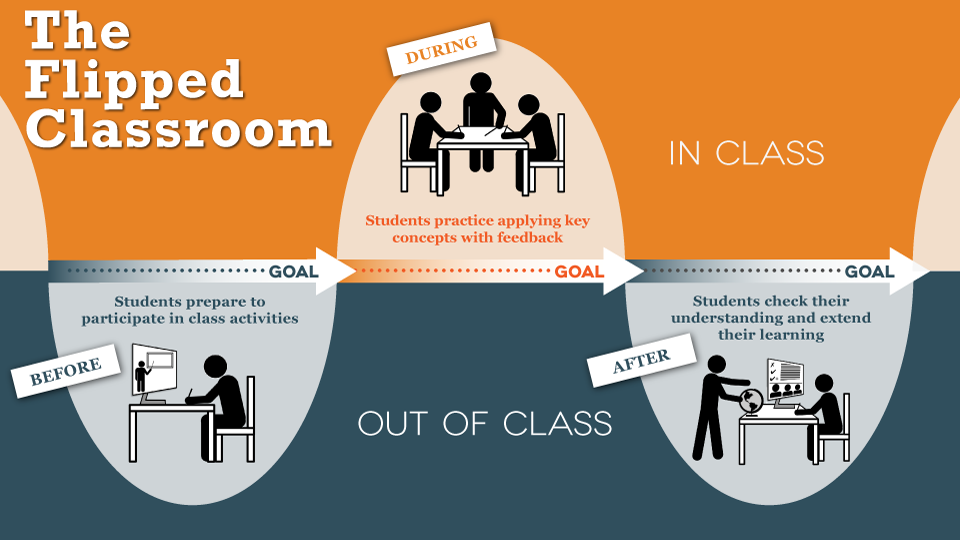26.1 – Theoretischer Hintergund

Teaching according to the ‘flipped classroom’ concept means that students prepare for classroom sessions in advance via mostly digital teaching materials such as lecture notes and videos, and that classroom time is then focused on exchange among students and instructors (for example in the context of group and project work, case studies and question sessions). The term ‘flipped’ reflects the procedure via which the initial imparting of theory and knowledge, which normally takes place in the classroom, becomes the province of independent study. The result is that students can use classroom sessions from the start to apply their knowledge via appropriate tasks [1]. This teaching concept is not new, but arose out of growing criticism of the static teaching of traditional lectures and developments such as that of Eric Mazur (Harvard), whose 1990s peer instruction method [2] showed how much students can learn from one another. The flipped classroom requires students to exercise significant personal responsibility and self-direction during the learning process. It also changes the role of faculty: developing suitable independent study materials and supervising students during group and project work assume major importance. Here the biggest challenge lies in adequate production of online materials and careful preparation of activities for classroom sessions.
Even if the flipped classroom concept is not new, it has been given new vitality with the digitalisation and increased flexibility of university teaching. The hype surrounding Massive Open Online Courses (MOOCs) is a factor here, together with the growing significance of other open and for-profit online independent study courses and the mass distribution of educational videos, especially those suitable for mobile devices. One of the great potentials of the flipped classroom is that direct exchange with students in targeted learning activities enables faculty to better detect misconceptions and errors of reasoning. Its faculty-student dialogue is more intensive, and students can deploy various scenarios to transfer knowledge from theory to practice [3]. Here the flipped classroom also helps students to acquire competences which are not only subject-related but also social and non-technical.
Flipped classroom is an instructional strategy and a type of blended learning that reverses the traditional learning environment by delivering instructional content, often online, outside of the classroom. It moves activities, including those that may have traditionally been considered homework, into the classroom. In a flipped classroom, students watch online lectures, collaborate in online discussions, or carry out research at home and engage in concepts in the classroom with the guidance of a mentor.
In the traditional model of classroom instruction, the teacher is typically the central focus of a lesson and the primary disseminator of information during the class period. The teacher responds to questions while students defer directly to the teacher for guidance and feedback. In a classroom with a traditional style of instruction, individual lessons may be focused on an explanation of content utilizing a lecture-style. Student engagement in the traditional model may be limited to activities in which students work independently or in small groups on an application task designed by the teacher. Class discussions are typically centered on the teacher, who controls the flow of the conversation.[1] Typically, this pattern of teaching also involves giving students the task of reading from a textbook or practicing a concept by working on a problem set, for example, outside school.[2]
The flipped classroom intentionally shifts instruction to a learner-centered model in which class time explores topics in greater depth and creates meaningful learning opportunities, while educational technologies such as online videos are used to deliver content outside of the classroom. In a flipped classroom, content delivery may take a variety of forms. Often, video lessons prepared by the teacher or third parties are used to deliver content, although online collaborative discussions, digital research, and text readings may be used.[3][4][5]
Flipped classrooms also redefine in-class activities. In-class lessons accompanying flipped classroom may include activity learning or more traditional homework problems, among other practices, to engage students in the content. Class activities vary but may include: using math manipulatives and emerging mathematical technologies, in-depth laboratory experiments, original document analysis, debate or speech presentation, current event discussions, peer reviewing, project-based learning, and skill development or concept practice[6][7] Because these types of active learning allow for highly differentiated instruction,[8] more time can be spent in class on higher-order thinking skills such as problem-finding, collaboration, design and problem solving as students tackle difficult problems, work in groups, research, and construct knowledge with the help of their teacher and peers.[9] Flipped classrooms have been implemented in both schools and colleges and been found to have varying differences in the method of implementation.[10]
Quellen: